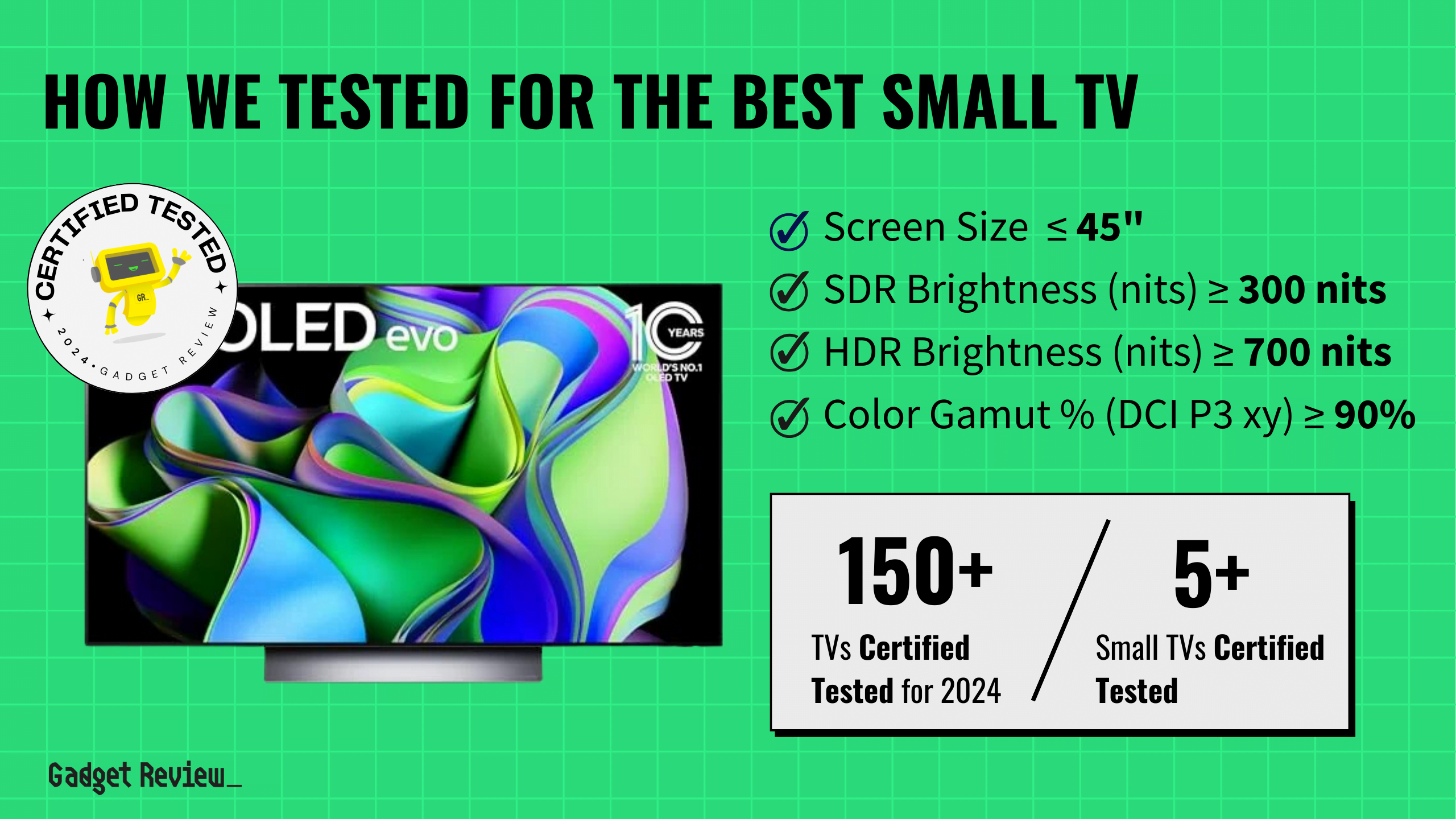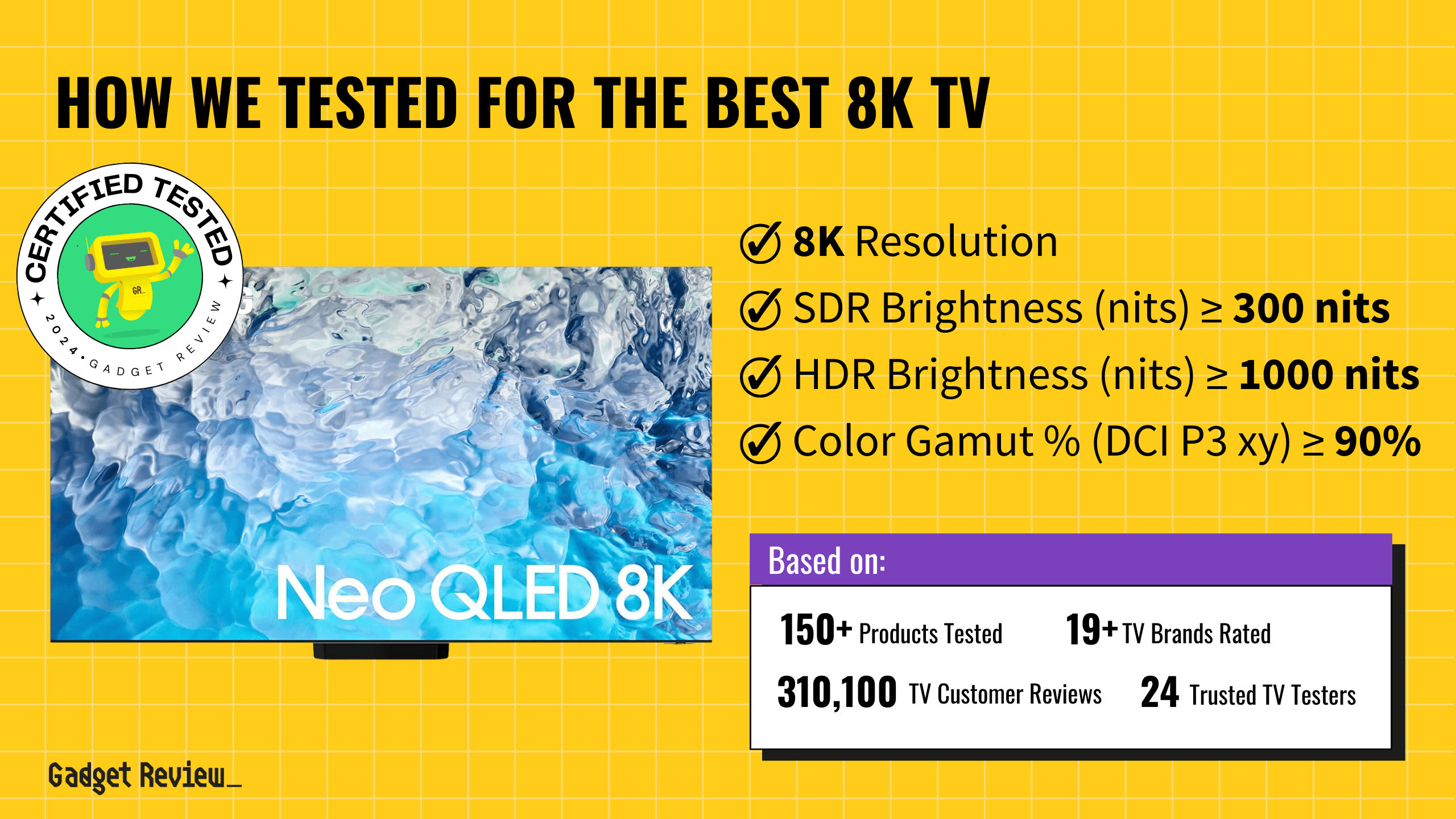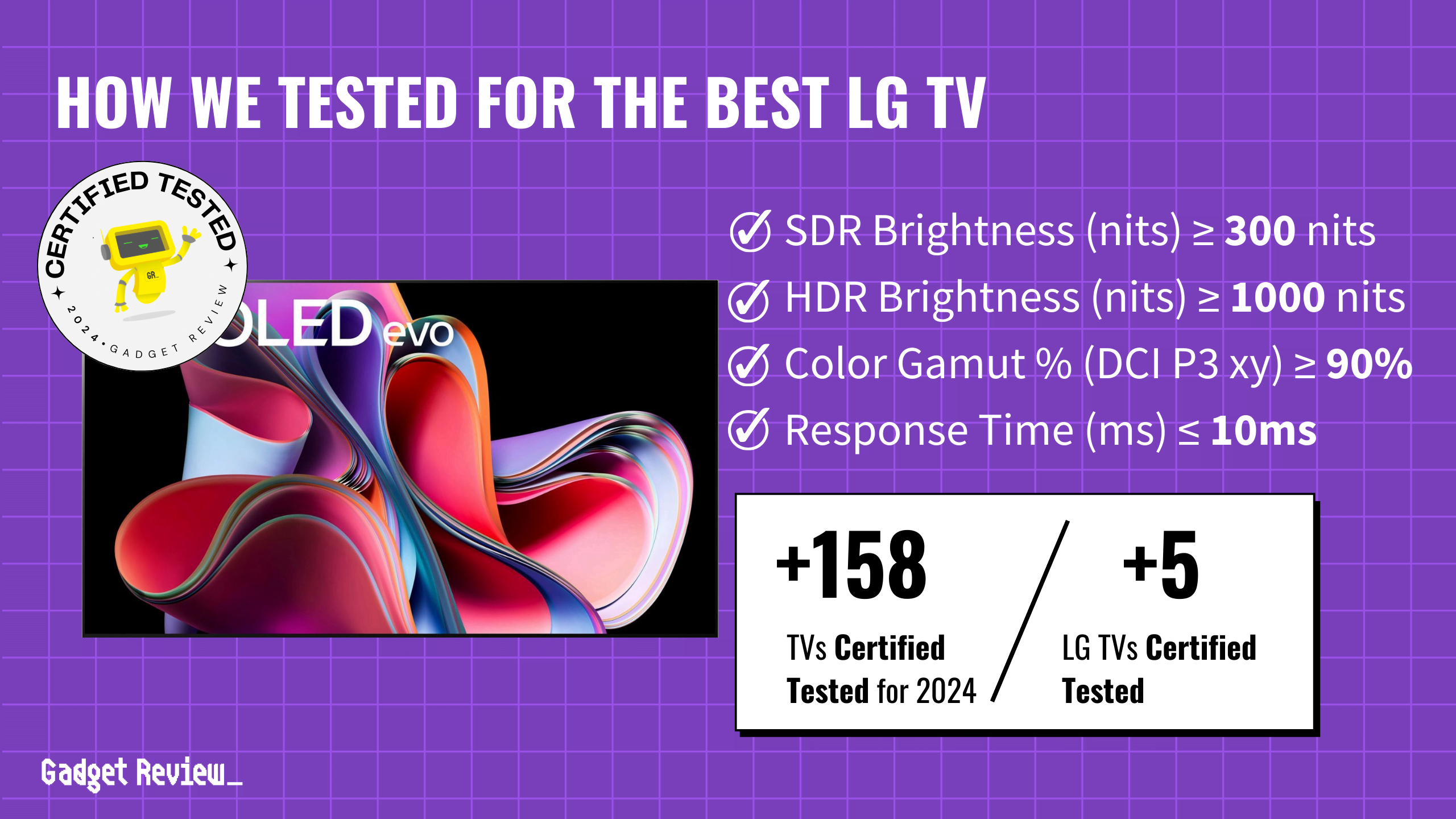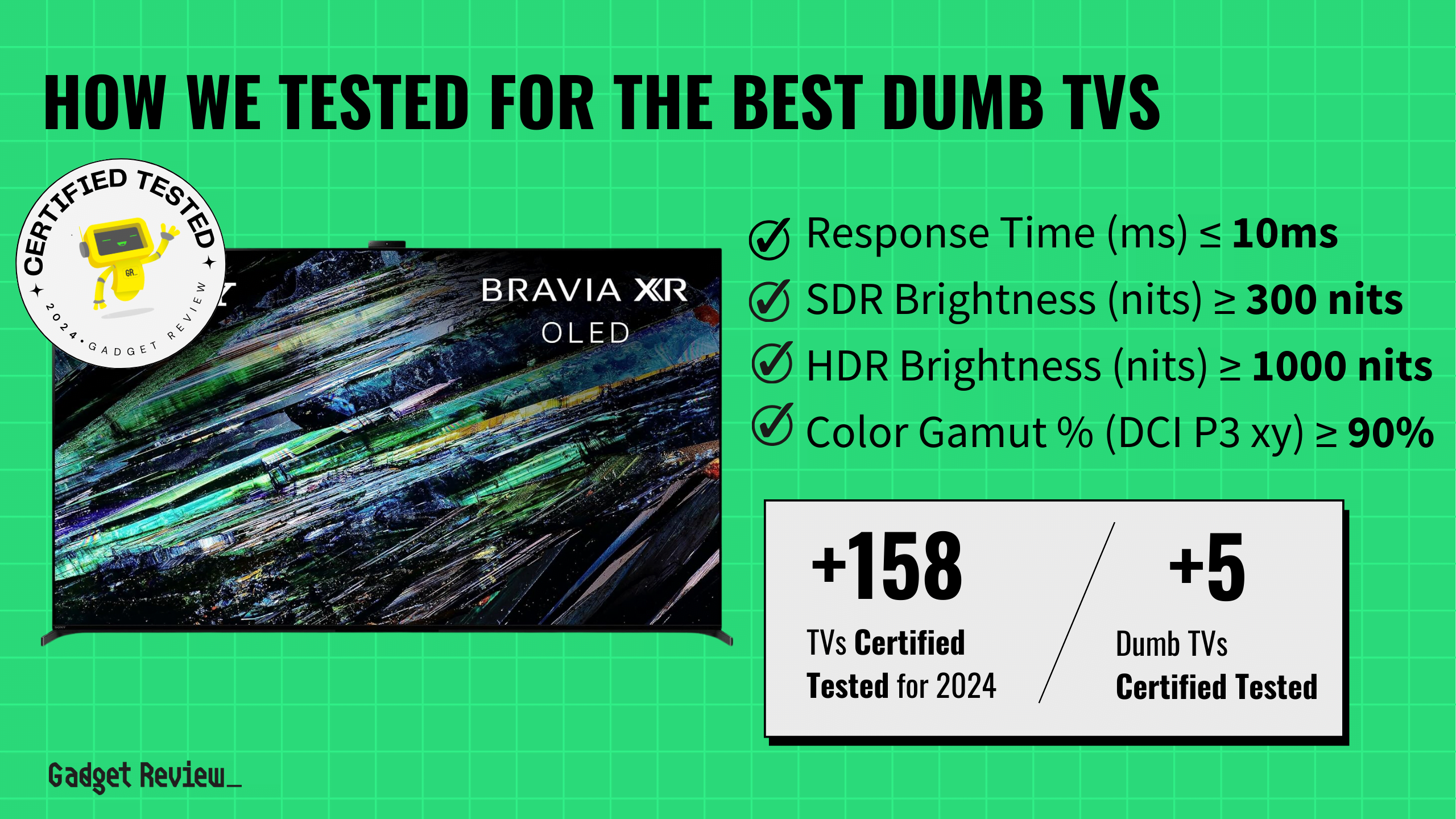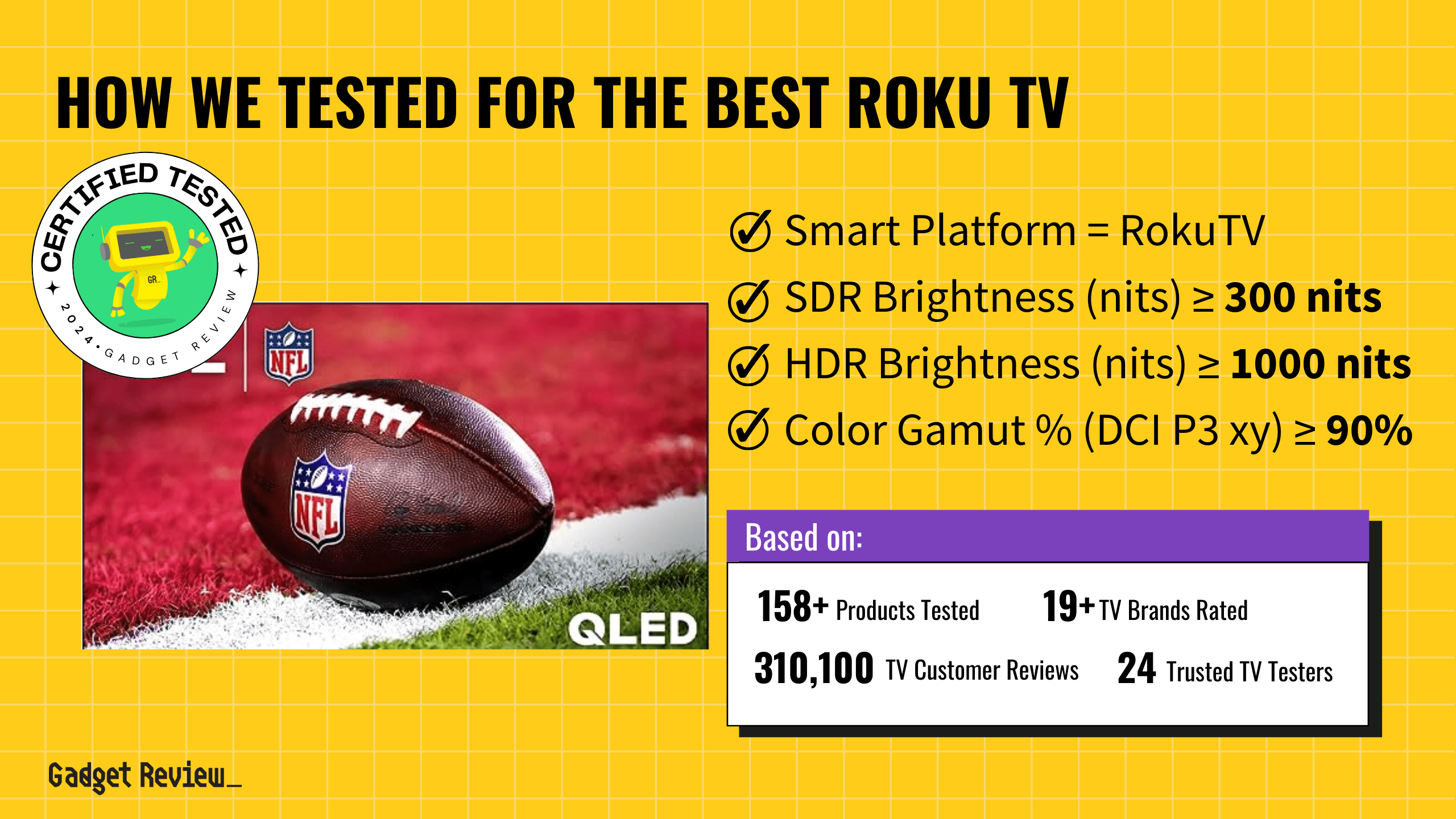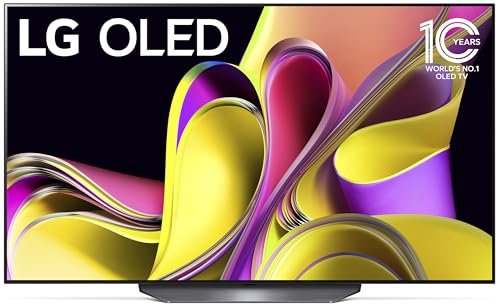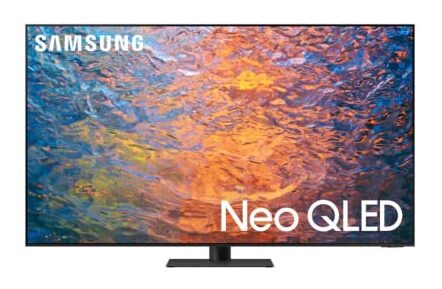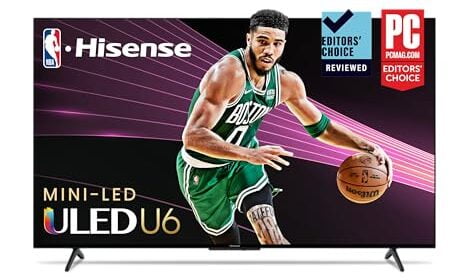When it comes to the best small TVs, size shouldn’t limit performance. Whether it’s for a kitchen, dorm room, or a mobile home, your TV must handle bright environments and still deliver exceptional picture quality.
We’ve meticulously combed through testing data and specs from more than 158 certified tested models to ensure you get the best bang for your buck. Our process is rigorous, focusing on performance in bright rooms and delivering top-notch visuals, so you don’t have to compromise. In our search for excellence, we’ve also included models that stand out among the best TVs overall, ensuring that even our small TV selections meet high standards of quality and performance. Read on to see how we zeroed in on the best small TVs that won’t let you down.
?️
Minimum Specifications
- Ideal Size: Under 45 inches, striking the perfect balance between compact and capable.
?
Test Criteria
- SDR Brightness: At least 300 nits for a bright, clear picture in any light.
- HDR Brightness: 700 nits and up, bringing out the detail in high dynamic range content.
- Color Accuracy: Minimum 90% DCI P3 color gamut for vibrant colors.
?
“Nice To Haves”
- Fast Response Time: 15ms or lower, keeping the action smooth without blur.
- Accurate EOTF Tracking: Delta less than 0.018, ensuring precise brightness and contrast.
- Robust Contrast Ratio: At least 10,000:1 for deep blacks and bright whites.
Keep reading to discover the top TV for small space. We’ve got options for the budget conscious, the value driven shopper, the home theater buff, the competitive gamer and for rooms that have an almost unmanageable amounts of direct or indirect light.
We’ve redefined TV buying guides, setting us apart from any other site on the planet. Our unique approach combines in-house verification with a comprehensive dataset from over 200+ trusted sites, focusing on key testing metrics to rank the top rated small TVs. Testing data (and specs) include brightness (SDR and HDR), color accuracy, and a set that is 45″ or smaller. We aggregate and analyze this data from 158+ TVs, ensuring our recommendations meet your specific needs. In this case its for small TVs, which means overcoming bright lights and fitting in a tight space. Discover our data-driven methodology for precise, reliable TV recommendations.
Latest Updates
- 02/20/2024: Completely and thoroughly overhauled the guide to include the best and latest small TVs.
- 11/28/2023: Republished the list to include TVs based on our True Score system.
Our commitment to unbiased reviews is powered by our ‘True Score’ system, targeting low quality and fake reviews. Commissions fund this mission. No bias. No BS. Learn more
Top 2 Small TVs

Best Overall

Runner Up
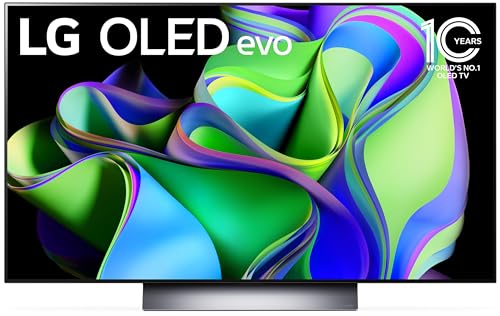 $839.00$1,300
$839.00$1,300Exceptional color accuracy, and best-in-class input and response times, making it the preferred choice for gamers. Its high brightness enhances versatility and serves as an excellent large monitor, all at the best value.
Screen size:
42", 48", 55", 65", 75", 83"
Display Type:
OLED

Best Overall

Runner Up
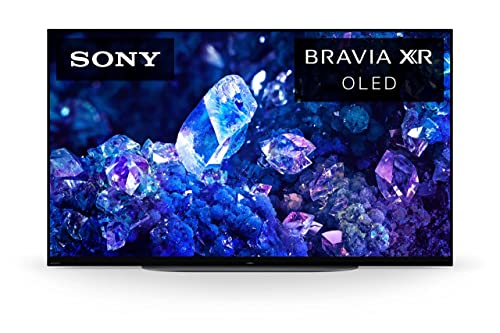 $1,298.00
$1,298.00The highest color gamut and accurate gamma, offering true color reproduction. Ideal for cinematic content, it’s less suited for competitive gaming, but perfect for those valuing premium cinematic experiences.
Screen size:
42", 48"
Display Type:
OLED
Top Small TVs For 2025
Prices accurate at the time of publishing
To snag a spot on our list, a small TV needs to be under 45 inches and capable of impressive color accuracy and brightness for both SDR and HDR content. If it doesn’t hit these points, we’re not including it!

Best Overall

Runner Up

Best Value

Best Budget

Best Mid-Range

Premium Pick
LG C3 OLED TV
Best For Gaming
Excels as a versatile small TV (42″ and up), offering superior color reproduction, low input lag, and high brightness, making it the top choice for gamers and those in brightly lit environments.

True Score
87879Experts
9311kCustomers
Absolutely Fresh
 SAVE $461$1,299.99$839.00
SAVE $461$1,299.99$839.00Snapshot
Reasons to Buy
- Excellent picture quality
- The near-infinite contrast ratio for perfect blacks
- Strong peak brightness
- High-performance motion handling
- Fast refresh rate
Reasons to Avoid
- Aggressive automatic brightness limiter
- Subpar sound quality
Specifications
Screen size 42", 48", 55", 65", 75", 83" Max Resolution 3840 x 2160 (4k) Refresh Rate 120 Hz 
Backlight Type No Display Type OLED HDMI Inputs 4 
HDMI Type HDMI 2.1 HDR Format Dolby Vision, HDR10, HLG 
HomeKit Compatible Yes 
LED Panel Type WOLED 
Number of Audio Channels 7.1.2 
Panel Type – 
Smart Platform webOS 
Speaker Output 20 Watts 
Sync Technology AMD FreeSync Premium, G-Sync 
VRR Yes All Specs
Test Results
SDR Brightness (nits) 383 HDR Brightness (nits) 795 Color Gamut % (DCI P3 xy) 98.98 Response Time (ms) 2.3 Contrast Ratio (x:1) 0 EOTF (600 nit delta) 0.0056 Color Gamut % (DCI P3 uv) 99.51 Color Gamut % (Rec 2020 xy) 73.28 Color Gamut % (Rec 2020 uv) 76.01 Color Gamut % (sRGB) 0 Color Gamut % (Rec 709) 0 Color Gamut % (BT.2020) 74.7 Color Gamut % (Adobe RGB) 0 Color Gamut % (BT.709) 0 Input Lag (ms) 9.6 Color Washout (Degrees) 63 Color Shift (Degrees) 34 Brightness Loss (Degrees) 70 Reflections (%) 1.1 Low-Freq Extension (Hz) 80 Freq Response StdDev @ 70db 1.14 Freq Response StdDev @ 80db 1.98 Weighted Total Harmonic Distortion @80db 0.085 Intermodulation Distortion @80db 4.49 EOTF (1000 nit delta) 0.0054 EOTF (4000 nit delta) 0.0051 All Tests
All Retailers
- $839.00$1,300Save $461
Availability
In StockFree Shipping
No - $896.99$1,297Save $400
Availability
In StockFree Shipping
- $897.99$900Save $2
Availability
Free Shipping
No - $996.99
Availability
In StockFree Shipping
No
Our Verdict
If you’re looking for vivid colors for your home theater, the LG C3 blends OLED performance with a small package. Its color gamut coverage of 98.98% DCI P3 xy ensures accurate color reproduction, crucial for delivering a true-to-life viewing experience across all content types. The LG C3’s SDR brightness of 383 nits and HDR brightness peaking of 795 nits position it excellently for both dark and brightly lit environments, enhancing its appeal for diverse home settings.
Through a combination of essential modern features such as HDMI 2.1, 4K resolution, and a 120Hz refresh rate, the C3 is able to tackle any content that comes its way. With its best-in-class input lag of 9.6 ms and best-in-class response time of 2.3 ms, the C3 is uniquely positioned as the optimal choice for gamers and sports fans alike seeking a TV that can fit into smaller spaces.
The excellent brightness offered by the C3 also allows it to perform well in brighter rooms, and it can double as a particularly large computer monitor in addition to its strong gaming and sports performance. It’s a versatile option that meets a broad range of entertainment needs in a compact package, at the lowest possible price on our entire list.

Best Overall

Runner Up

Best Value

Best Budget

Best Mid-Range

Premium Pick
Sony A90K OLED TV
Ideal for cinematic enthusiasts, it combines unparalleled color accuracy and deep blacks in a compact size, perfect for immersive home theater experiences but at a heftier cost than its size would suggest.

True Score
86867Experts
921kCustomers
Absolutely Fresh
 $1,298.00
$1,298.00Snapshot
Reasons to Buy
- Excellent picture quality
- High contrast ratio
- Low-tested response time and input lag
- Fast refresh rate and VRR support
- Wide viewing angles
Reasons to Avoid
- Limited HDR peak brightness
Specifications
Screen size 42", 48" Max Resolution 3840 x 2160 (4k) Refresh Rate 120 Hz 
Backlight Type No Display Type OLED HDMI Inputs 4 
HDMI Type HDMI 2.1 HDR Format Dolby Vision, HDR10, HLG 
HomeKit Compatible Yes 
Number of Audio Channels 7.1 
Panel Type RWBG 
Smart Platform Google TV 
Speaker Output 10W + 10W + 5W 
Sync Technology No 
VRR Yes All Specs
Test Results
SDR Brightness (nits) 288 HDR Brightness (nits) 593 Color Gamut % (DCI P3 xy) 99.375 Response Time (ms) 3 Contrast Ratio (x:1) 0 EOTF (600 nit delta) 0.004 Color Gamut % (DCI P3 uv) 99.67 Color Gamut % (Rec 2020 xy) 73.54 Color Gamut % (Rec 2020 uv) 78.83 Color Gamut % (sRGB) 0 Color Gamut % (Rec 709) 0 Color Gamut % (BT.2020) 71.2 Color Gamut % (Adobe RGB) 0 Color Gamut % (BT.709) 0 Input Lag (ms) 16.9 Color Washout (Degrees) 58 Color Shift (Degrees) 31 Brightness Loss (Degrees) 61 Reflections (%) 1.8 Low-Freq Extension (Hz) 126.99 Freq Response StdDev @ 70db 4.02 Freq Response StdDev @ 80db 4.58 Weighted Total Harmonic Distortion @80db 0.14 Intermodulation Distortion @80db 0.47 EOTF (1000 nit delta) 0.0041 EOTF (4000 nit delta) 0.0041 All Tests
All Retailers
- $1,298.00
Availability
In StockFree Shipping
No - $1,298.00$1,300Save $2
Availability
In StockFree Shipping
No - $1,299.99
Availability
In StockFree Shipping
No
Our Verdict
The Sony A90K OLED TV is one of the best small TVs on our list, offering home theater performance in a compact 42” package. With a best-in-class color gamut and EOTF of 99.38% DCI P3 xy and 0.004 respectively, the A90K is uniquely positioned to offer the truest color reproduction and most accurate gamma.
Despite its modest SDR and HDR brightness levels (288 and 593 nits, respectively), the A90K’s OLED panel helps it deliver deep blacks with a nearly infinite contrast ratio. It also supports HDMI 2.1 and has a 120Hz refresh rate, making it future-ready for all entertainment forms. And streaming your favorite shows or movies shouldn’t be a problem thanks to Google TV.
Its quick response time of 3.0 ms means the A90K can also handle sports content with ease, but the high input lag of 16.9 ms keeps it from being the go-to choice for competitive gaming, and better suited instead for more casual play.
Overall, the A90K is ideal for anyone looking to squeeze as much cinematic performance out of as small a package as possible and doesn’t mind paying the premium that comes with looking for the best possible home theater experience.
DID YOU KNOW 87% OF TV REVIEWERS ARE UNTRUSTWORTHY?
Our research found 28 of 210 TV reveiwers can be trusted, and shockingly 1 out of 3 on Google Page 1 were fake reviews showing no proof of test claims. See our Expose and Trust List. This is why Gadget Review is committed to calculating the most accurate product scores on the web.
To do this, we give every TV review site a Trust Rating, which measures how trustworthy the site and their testing claims are. We then leverage AI & a machine learning model to combine and calculate the Trust Rating with data from experts and consumers to deliver the True Score, the web’s most accurate product quality rating.

Best Overall

Runner Up

Best Value

Best Budget

Best Mid-Range

Premium Pick
Samsung QN90C NEO QLED Series
Best For Bright Room
Brightest in class, it shines in well-lit spaces with its exceptional brightness and color quality, balancing slight gaming and sports content compromises for vivid clarity.
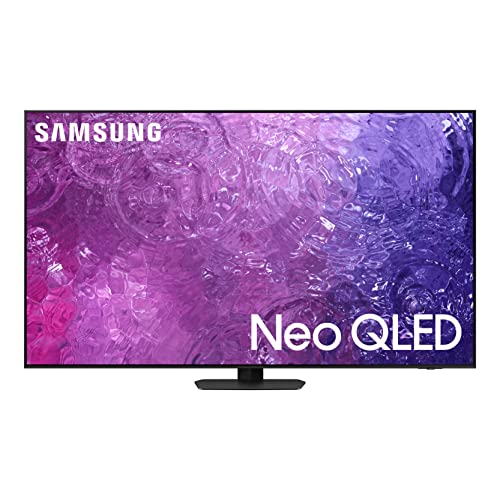
True Score
86869Experts
925kCustomers
Absolutely Fresh
 SAVE $1$1,299.99$259.99
SAVE $1$1,299.99$259.99Snapshot
Reasons to Buy
- Superb picture quality
- High brightness and contrast
- Low-tested response time and input lag
- High refresh rate and VRR support
Reasons to Avoid
- Moderate viewing angle
- Mild blooming
Specifications
Screen size 43", 50", 55", 65", 75", 85" Max Resolution 3840 x 2160 (4k) Refresh Rate 120 Hz 
Backlight Type Full-Array Display Type LED HDMI Inputs 4 
HDMI Type HDMI 2.1 HDR Format HDR10+, HLG 
HomeKit Compatible No 
Number of Audio Channels 4.2.2 
Panel Type Neo QLED 
Smart Platform Tizen 
Speaker Output 60 watts 
VRR Yes 
Works With Amazon Alexa, Bixby, Bluetooth, Google Assistant, Remote Control, SmartThings, Wi-Fi All Specs
Test Results
SDR Brightness (nits) 1,289 HDR Brightness (nits) 1,923 Color Gamut % (DCI P3 xy) 93.335 Response Time (ms) 10.2 Contrast Ratio (x:1) 83,200 EOTF (600 nit delta) 0.0046 Color Gamut % (DCI P3 uv) 93.64 Color Gamut % (Rec 2020 xy) 72.73 Color Gamut % (Rec 2020 uv) 75.69 Color Gamut % (sRGB) 98 Color Gamut % (Rec 709) 99.77 Color Gamut % (BT.2020) 73 Color Gamut % (Adobe RGB) 79.1 Color Gamut % (BT.709) 0 Input Lag (ms) 10 Color Washout (Degrees) 26 Color Shift (Degrees) 51 Brightness Loss (Degrees) 32 Reflections (%) 1.5 Low-Freq Extension (Hz) 100.79 Freq Response StdDev @ 70db 1.61 Freq Response StdDev @ 80db 2.38 Weighted Total Harmonic Distortion @80db 0.334 Intermodulation Distortion @80db 0.31 EOTF (1000 nit delta) 0.0046 EOTF (4000 nit delta) 0.0044 All Tests
All Retailers
- $259.99$1,300Save $1
Availability
In StockFree Shipping
No - $748.95
Availability
In StockFree Shipping
- $1,077.00$1,999Save $922
Availability
In StockFree Shipping
No - $1,297.95
Availability
In StockFree Shipping
No
Our Verdict
If you’re looking for the absolute brightest TV in the smallest package possible, the Samsung QN90C NEO QLED is precisely what you need. While its color gamut of 93.34% DCI P3 xy lags behind the others on the list, it’s still respectable – especially for a QLED. The reduced gamut coverage is also offset by the best-in-class SDR and HDR brightness levels—1289 nits and 1923 nits, respectively. This makes the QN90C an ideal choice for brightly lit environments where its superior brightness can truly shine, enhancing visibility and detail in high ambient light conditions.
Like the other TVs on this list, the Samsung QN90C incorporates HDMI 2.1 and a 120Hz refresh rate, making it well-equipped to handle the latest 4K content, and providing a seamless experience for fast-paced action movies, sports, and gaming with minimal tearing.
While the Samsung QN90C NEO QLED Series exhibits the highest response time on our list at 10.2 ms, the TV’s input lag of 10.0 ms only slightly trails the C3’s, making the QN90C a great choice for high-intensity gaming, even if the higher response time means it’ll struggle more (but not much) than other TVs would when handling sports content.
Overall, as far as small TV options go, the QN90C is ideal for those prioritizing brightness and clarity in their viewing experience. Its similar price point to the LG C3 positions the TV as the QLED counterpart, trading some of the performance when gaming or watching sports for exceptionally high brightness.

DON’T SEE WHAT YOU’RE LOOKING FOR?
Certain brands often stand out when looking at the best TV brands with their cutting-edge technology and superior quality offerings, from the immersive experience of the best OLED TVs to the stunning detail of the best 8K TVs. If you are considering these latest models, ensure you understand the differences between 4K and 8K.
Moreover, the best TV monitors offer versatility for those who need a TV that caters to both work and entertainment. Additionally, understanding how to connect a soundbar can significantly improve the audio experience of your setup. Lastly, those with limited space will find the top 24-inch TVs can offer the perfect balance of size, performance, and power efficiency.

Best Overall

Runner Up

Best Value

Best Budget

Best Mid-Range

Premium Pick
LG Flex OLED TV
With its unique bendable design, it offers unparalleled flexibility and immersive viewing, marrying innovative form with solid gaming and cinematic performance, but at a premium price.
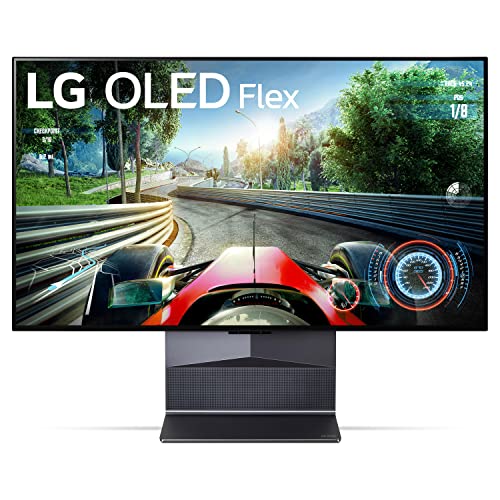
True Score
85852Experts
9114Customers
Absolutely Fresh
 SAVE $600$2,499.99$1,899.99
SAVE $600$2,499.99$1,899.99Snapshot
Reasons to Buy
- Exceptional picture quality
- Impressive brightness and contrast
- Variable Refresh Rate support
- Exceptional reflection handling
- Incredible response time
Reasons to Avoid
- Limited height adjustment and no VESA support
- Adjustable screen reverts to a flat position when off
- Risk of permanent burn-in
- Limited height adjustment and no VESA support
- The glossy display may cause reflections in bright lighting conditions
- Screen reverts to a flat position when off, which can be inconvenient
- The price may be high for some consumers
Specifications
Screen size 42" Max Resolution 3840 x 2160 (4k) Refresh Rate 120 Hz 
Backlight Type Full-Array Display Type OLED HDMI Inputs 4 HDR Format Dolby Vision, HDR10, HLG 
LED Panel Type OLED 
Smart Platform webOS 
Sync Technology AMD FreeSync, G-Sync 
VRR Yes All Specs
Test Results
SDR Brightness (nits) 374 HDR Brightness (nits) 738 Color Gamut % (DCI P3 xy) 97.92 Response Time (ms) 2.5 Contrast Ratio (x:1) 0 EOTF (600 nit delta) 0.0028 Color Gamut % (DCI P3 uv) 99.19 Color Gamut % (Rec 2020 xy) 71.3 Color Gamut % (Rec 2020 uv) 74.64 Color Gamut % (sRGB) 0 Color Gamut % (Rec 709) 0 Color Gamut % (BT.2020) 0 Color Gamut % (Adobe RGB) 0 Color Gamut % (BT.709) 0 Input Lag (ms) 10 Color Washout (Degrees) 52 Color Shift (Degrees) 28 Brightness Loss (Degrees) 69 Reflections (%) 0.9 Low-Freq Extension (Hz) 113.14 Freq Response StdDev @ 70db 2.74 Freq Response StdDev @ 80db 2.83 Weighted Total Harmonic Distortion @80db 0.034 Intermodulation Distortion @80db 1.95 EOTF (1000 nit delta) 0.0024 EOTF (4000 nit delta) 0.0025 All Tests
All Retailers
- $1,899.99$2,500Save $600
Availability
In StockFree Shipping
No Availability
Free Shipping
Our Verdict
The LG Flex OLED TV, with its unique position in the small TV market, offers an innovative approach to viewing experiences. Although it has the highest price point among the models listed, its distinct feature set, including a bendable screen, caters to a niche yet growing demand for versatile and immersive entertainment setups. With a color gamut coverage of 97.92% DCI P3 xy, it demonstrates a strong ability to deliver vivid and accurate colors, essential for both cinematic content and vibrant gaming visuals.
It stands out primarily because of the adaptability offered by its flexible screen. Its SDR and HDR brightness levels, at 374 nits and 738 nits respectively, aren’t the highest, but it’s still an OLED TV and therefore offers deep blacks and a near-infinite contrast ratio.
Furthermore, an input lag of 10.0 ms and a response time of 2.5 ms ensure that it remains a competitive choice for gaming and place it just behind the best performing TV for both metrics (the C3.) This makes the Flex particularly attractive to anyone looking for a screen that can transition between a flat and curved display to help improve immersion in a game or show.
Overall, the Flex is able to carve out its own space in the small TV market by offering a flexible viewing experience that can be tailored to the user’s preference. Its performance, coupled with the unique bendable feature, makes it a compelling option for tech enthusiasts and those seeking a premium, adaptable display for their entertainment center.

Our Approach to Testing TVs For Small TVs
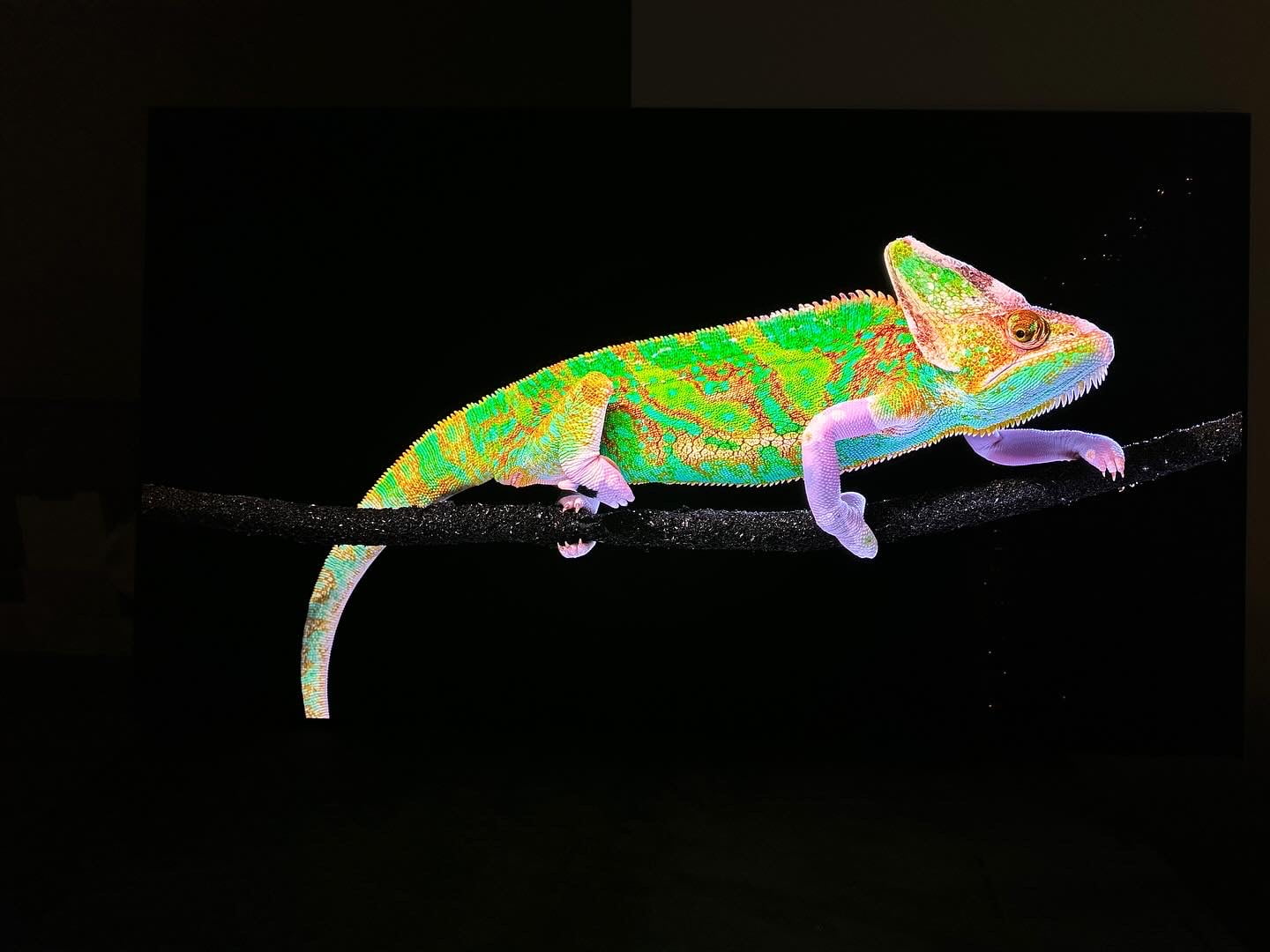
Evan Shepard/Gadget Review
We’ve redefined TV buying guides, setting us apart from any other site on the planet. Our unique approach combines in-house verification with a comprehensive dataset from trusted sites, focusing on key testing metrics like brightness (SDR and HDR), EOTF, response time, contrast ratio, and color accuracy.
We aggregate and analyze this data, ensuring our recommendations meet the specific needs. In this case, it’s for small TVs, which means overcoming bright lights and fitting in tight spaces. Discover our data-driven methodology for precise, reliable TV recommendations.
You may notice some of our graphs contain “Source: RTings”. This is to indicate that the data we’re showing off in a graph has come from a single source – because it’s the only source that actually tested the criteria and had data for it! Normally, our data is an average out of all of the various publications that test and provide data to give you a good idea of how a product is going to perform on average.
Which Criteria Matter for Testing Small TVs?
By focusing on these criteria (3 required, 3 nice to have), anyone can quickly and easily compare these TVs and how they’ll perform. This helps you make an informed decision and purchase a TV that will fit into your small or tight space.
| CRITERIA | RANGE | REQUIRED | DEFINITION |
|---|---|---|---|
| SDR Brightness | 300+ nits | Yes | Assess the luminance of your display when operating in Standard Dynamic Range (SDR) mode. |
| HDR Brightness | 700+ nits | Yes | Determine the luminance of your display in High Dynamic Range (HDR) mode. |
| Color Gamut (DCI P3 xy) | >= 90% | Yes | Evaluate the extent to which a TV can reproduce a specified spectrum of colors. |
| EOTF | 0.018 | No (nice to have) | Standard that governs how a display interprets and renders brightness and color. |
| Response Time | <=15ms | No (nice to have) | Time required for a pixel to transition from one color to another and then return to its original color. |
| Contrast Ratio | >= 10,000 | No (nice to have) | The ratio between the brightest white and darkest black that the screen can display. |
Our Trusted Data Sources
(Publication category Score is 80%+)
We looked at 210+ TV reviewers and while 24 are trustworthy (60%+ Trust Rating), we only use data from the testers that are “very trusted” which means a Trust Rating above 70%. The three we have listed below are our most trusted for TVs, along with our own in-house TV expert.
- Evan Shepard – Gadget Review
- Matthew Lopes – RTings, MuckRack
- Will Greenwald – PCMag, MuckRack, Twitter
- David Katzmaier – CNET, MuckRack, Twitter
Interested in a comprehensive analysis of our data sources? We’ve got you covered. Below, you’ll find a detailed list of every TV review website we’ve identified, organized by their respective Trust Ratings from highest to lowest. But we didn’t stop there. We’ve meticulously reviewed each publication and verified the data by checking whether the authors have bio links to MuckRack or LinkedIn. We’re committed to not only checking the facts but ensuring their veracity.
TV Test Data & Results
1. SDR & HDR Brightness TV Test Results
In brightly lit rooms, the brightness of your TV, measured in nits, is crucial for a good viewing experience. If your TV isn’t bright enough, ambient light can overpower the screen, making images hard to see, washed out, and lacking in detail. Think of nits as the strength of your TV’s display against sunlight or room lights. The higher the nits, the clearer and more vibrant the picture.
For everyday viewing of standard dynamic range (SDR) content, aiming for a TV with at least 300 nits, providing a decent balance between visibility and picture quality. However, when stepping up to high dynamic range (HDR) content, which enhances picture quality with more depth and vibrant colors, a brightness of at least 700 nits offers a significantly better experience. While these numbers aren’t mandatory, they serve as a solid guideline for ensuring your TV can deliver a vivid, detailed picture even in well-lit spaces. Remember, the brighter, the better for overcoming ambient light and enjoying your favorite content without compromise.
Among the best Samsung TVs, models like you’ll find in our Samsung QN9DA review stand out for their brightness, making it ideal for well-lit rooms.
Discover the top small TVs, ranked from brightest to least.
Brightness
SDR: 300+ nits
HDR: 700+ nits
Acceptable range of performance
Definition: Maximum brightness in a specified pattern size window. Most commonly measured in a 10% or 100% white window.
Units of Measurement: nits (alternatively cd/m²)
Tools to Measure: TV, luminance meter
Why It’s Important:
Brightness helps counter ambient light so that details and colors don’t wash out and get lost.
SDR Brightness (in nits, higher is better)
HDR Brightness (in nits, higher is better)
2. Color Gamut (DCI P3 xy) TV Test Results
Color gamut defines the range of colors a small TV can reproduce, directly affecting how vibrant and true-to-life the images look. A wide color gamut in a compact TV brings out richer, more vivid colors – from the lush greens of a garden to the bright colors of animated characters, enhancing your viewing experience to closely mimic real life.
This concept is technically measured against standards like the DCI P3 xy, a benchmark for high-quality visuals. A small TV covering a higher percentage of this color space can display colors more accurately and vividly.
For those who prioritize vibrant and immersive visuals in a smaller package, aiming for a small TV with a color gamut of 90% or higher on the DCI P3 xy scale is ideal. This ensures that the content you watch is as vibrant and lifelike as possible, bringing a big viewing experience to a smaller screen.
Below are the top small TVs, ordered by color gamut, all exceeding our testing criteria.
Color Gamut
>= 90%
Acceptable range of performance
Definition: The TV’s capability to display a spectrum of colors.
Units of Measurement: % (color space coverage in percent)
Tools to Measure: Colorimeter
Why It’s Important:
Inaccurate colors compromise the authenticity of the content.
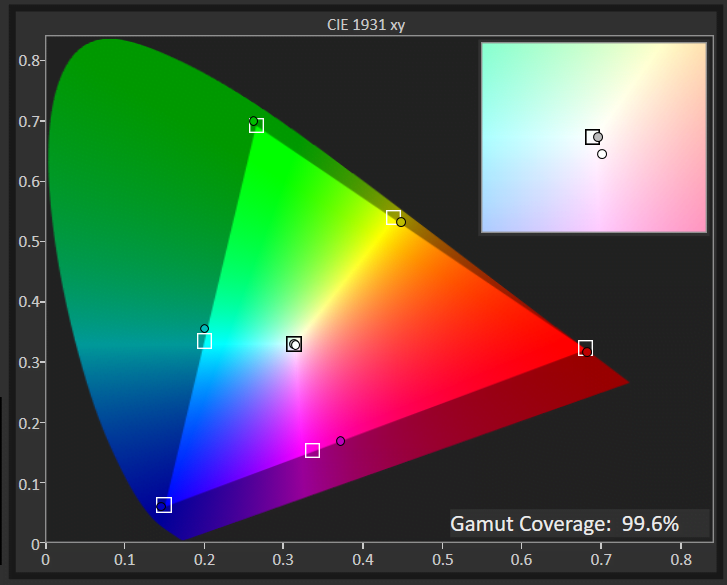
DCI P3 XY Color Gamut (as a %; high is better)
3. EOTF Test Results
EOTF
< 0.018 (600 nit Δ)
Acceptable range of performance
Definition: How your TV interprets and renders the luminance data from content and translates it to be represented on screen. If EOTF/Gamma tracking is too low or too high, it will result in an over-brightened or over-darkened image from reference.
Units of Measurement: this test measures for the delta from the standard
Tools to Measure: Luminance colorimeter
Why It’s Important:
EOTF ensures that the game is displayed (color and HDR brightness) as the creator intended it
The Electro-Optical Transfer Function (EOTF) plays a critical role in ensuring the content on your TV looks exactly as the creator intended. This technical feature adjusts your screen’s brightness levels, ensuring every scene, from the darkest shadows to the brightest highlights, is displayed with true-to-life accuracy.
In rooms flooded with light, a TV that nails EOTF calibration shines by preserving the intended contrast and detail in the picture despite the challenging conditions. It balances the brightness so that images remain vibrant and full of detail, unaffected by the glare of ambient light.
A TV that excels in managing EOTF offers an immersive and authentic viewing experience. It brings creators’ visions to life, accurately rendering every scene with the proper light and dark levels, no matter the lighting in your room. This means you get a consistent, realistic picture that captures the full spectrum of colors and contrasts, from the subtlest hues to the most intense explosions.
Below are all the small TVs on our list, ordered by EOTF, all exceeding our minimum requirement.
EOTF (source: rtings.com – 0 = no data exists; lower is better)
4. Response Time TV Test Results
Response Time
1ms-15ms
Acceptable range of performance
Definition: Speed at which a pixel transitions from one color to another
Units of Measurement: milliseconds (ms)
Tools to Measure: Screen, camera, test software
Why It’s Important:
A faster response time means less blur and thus more accuracy
A slow response time on a small TV during fast-paced scenes is like trying to watch a thrilling movie with a foggy lens. Imagine settling in for an action-packed sequence, only to have the swift movements turn into a blur, robbing you of the crisp, clear detail you crave. This isn’t just a minor annoyance; it’s a major detriment to your viewing experience, leaving you with a picture marred by motion blur and visual artifacts.
So, what exactly is response time? It measures how quickly a pixel on your TV can change from one color to another. In the context of watching fast-moving content or enjoying dynamic scenes on a small TV, a low response time is crucial. A response time of 15 ms or lower is good, but if you plan on gaming on this set, aim for a response time of 10 ms or lower. At these levels, your small TV ensures smooth transitions and sharp visuals, making every scene come to life without any distracting blurs or delays.
For gaming enthusiasts, the LG UN7300 has a low response time, making it a top-tier TV for sports and fast-paced gaming.
Below are the top small TVs, ordered by response time, all exceeding our testing criteria.
Response Time (in milliseconds; lower is better)
5. Contrast Ratio
Contrast Ratio
>=10,000:1
Acceptable range of performance
Definition: Difference between the darkest black and the brightest white a screen can display.
Units of Measurement: cd/m2
Tools to Measure: Luminance meter
Why It’s Important:
A higher contrast ratio delivers deeper blacks, enhancing content definition, especially in darker rooms.
For small TV enthusiasts, a solid contrast ratio is crucial for enjoying your favorite TV shows or movies, especially in darker settings. This feature directly impacts how lifelike and dynamic the picture appears on your screen, ensuring that dark scenes are displayed with clear, crisp blacks instead of murky grays and bright scenes retain their detail without appearing washed out.
Put simply, the contrast ratio is all about the range of luminance a TV can produce, from the deepest blacks to the brightest whites. It’s what brings depth to the image, enhancing the realism of every scene. Watching a movie in the dark, for example, the difference between a TV with a poor contrast ratio and one with a high ratio is stark: the former struggles, blending shadows into a flat gray, while the latter delivers true black, making night scenes more immersive and detailed.
Ideally, a contrast ratio of 10,000:1 is what you should aim for in a small TV. This level of luminance variance ensures that you’re getting a picture quality that can handle the nuances of lighting in any scene, providing a viewing experience that’s both rich and engaging. Note: OLED TVs have an infinite contrast ratio, indicated by “0.”
Below are the top small TVs, ordered by contrast ratio, all exceeding our testing criteria.
Contrast Ratio (higher is better)
Small TVs: Mistakes To Avoid
- Underestimating Brightness: Brightness is crucial, particularly for small TVs that might be placed in areas with varying light conditions like kitchens or dorm rooms. A brighter screen ensures a clear, visible picture regardless of ambient light.
- Neglecting Physical Dimensions and Input Accessibility: Measure your available space and the TV’s dimensions to ensure a good fit. It’s crucial to understand the relationship between TV size vs distance for an optimal viewing experience. Remember that TV sizes and stands vary, and accessible inputs are essential for your setup, especially in tight spaces.
- Overlooking Gaming Performance: If gaming is on your agenda, don’t overlook a TV’s gaming capabilities. Models like the LG C3 is one of the best gaming TVs, offering features that can elevate your gaming experience. Consider this aspect if gaming is important to you.
- Focusing Too Much on Operating Systems: While it’s tempting to choose a TV based on its smart platform, remember that most TVs today have access to a wide array of streaming apps. Unless you have specific smart home integrations that require compatibility, the operating system should not be a deal-breaker.
The Best Small TV Tests Compared
Product |
True Score
|
SDR Brightness
|
HDR Barightness
|
Color Gamut
|
Response Time
|
EOTF
|
Contrast Ratio
| |
|---|---|---|---|---|---|---|---|---|
| 87 |
|
|
|
|
|
| $839.00 $1,300 $461 |
| 86 |
|
|
|
|
|
| $1,298.00 |
| 86 |
|
|
|
|
|
| $1,097.99 |
| 85 |
|
|
|
|
|
| $1,899.99 $2,500 $600 |


